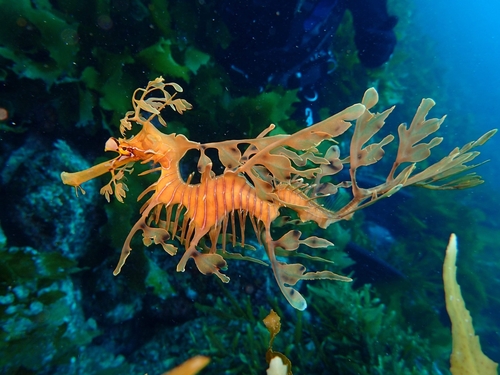
Leafy Seadragon
The Atlantic bluefin tuna (Thunnus thynnus) is a magnificent and highly migratory species of tuna found in the Atlantic Ocean. Renowned for its size, speed, and commercial value, it plays a crucial role in the marine ecosystem. This species has been prized for centuries, but overfishing has severely impacted its population.
6 10 years
Lifespan
20 - 24 cm
Length
Least Concern
Conservation Status
0.15 km/h
Swimming speed
Carnivorous
Diet
Sedentary
Migration
Appearance Overview
The Atlantic bluefin tuna is a large, torpedo-shaped fish with a streamlined body built for speed and endurance.
Color
Dark metallic blue on top, silvery-white on the underside
Fins
Two dorsal fins, the first is depressible; small finlets run from the dorsal and anal fins to the tail
Body
Streamlined, fusiform body shape
Length
Up to 13 feet (4 meters), commonly 6.5-8 feet (2-2.5 meters)
Weight
Up to 2,000 lbs (900 kg), commonly around 550 lbs (250 kg)
Diet
Carnivorous, feeding on a variety of fish (such as herring, mackerel, and hake), squid, crustaceans, and eels.
Feeding Behavior
Highly active predator that uses its speed and agility to hunt. They often hunt cooperatively, herding prey into tight formations before striking.
Social Behavior
Forms large schools, particularly when young. Adults may travel alone or in smaller groups. Highly migratory, traveling long distances across oceans.
Commercial Relevance
Extremely high value, particularly in the Japanese sushi and sashimi market, where a single fish can fetch hundreds of thousands of dollars.
Conservation measures
Subject to international fishing quotas and regulations managed by organizations like ICCAT. Marine protected areas and fishing gear restrictions are also in place in some regions.
Status
Endangered (Varies by population segment; some are considered critically endangered)
Threats
Overfishing (historically and ongoing), bycatch in fishing gear, climate change affecting prey distribution and spawning grounds, and habitat degradation.
Habitat Distribution
Depth Range
Surface waters to depths of over 3,000 feet (1,000 meters)
Geographic Range
Western and Eastern Atlantic Ocean, including the Mediterranean Sea. Absent from the Black Sea.
Preferred Environment
Primarily pelagic (open ocean), but also found in coastal waters. Prefers temperate waters.
Reproduction and Life Cycle
Breeding Habits
Spawns in specific areas of the Mediterranean Sea and the Gulf of Mexico. Spawning typically occurs in warmer waters during specific times of the year (May-June in the Gulf of Mexico, June-July in the Mediterranean).
Development Stages
Eggs hatch into larvae, which are planktonic. They grow rapidly, developing through juvenile stages before reaching adulthood. Growth rates are influenced by water temperature and food availability.
Fecundity
Highly fecund; a single female can release up to 30 million eggs per spawning season. Egg production is related to the size and age of the female.
Maturity Age
Reaches sexual maturity at different ages depending on location: around 4-5 years in the Mediterranean and 8-12 years in the western Atlantic.
Faqs about Leafy Seadragon
Where are Atlantic bluefin tuna found?
Atlantic bluefin tuna are found in the Atlantic Ocean, ranging from the Gulf of Mexico and the Mediterranean Sea to the cold waters of Canada and Norway.
What do Atlantic bluefin tuna eat?
Atlantic bluefin tuna are carnivores, feeding on a wide variety of fish, squid, crustaceans, and other marine animals.
How far do Atlantic bluefin tuna migrate?
Atlantic bluefin tuna are highly migratory and can travel thousands of miles across the ocean.
At what age do Atlantic Bluefin Tuna reach maturity?
They reach sexual maturity between 4-8 years, varying by location and population.
How many eggs can an Atlantic Bluefin Tuna lay?
A female can release up to 30 million eggs per spawning season.
How long do Atlantic Bluefin Tuna live?
Their lifespan can be up to 40 years.
Are Atlantic Bluefin Tuna still fished commercially?
Yes, but due to overfishing, their populations have declined significantly. Stringent fishing regulations are in place.
What is ICCAT?
ICCAT is the International Commission for the Conservation of Atlantic Tunas, responsible for the management of tuna and tuna-like species in the Atlantic Ocean.
Copyright @ Nature Style Limited. All Rights Reserved.
 English
English